Ozone Trends from Two Decades of Ground Level Observation in Malaysia
Abstract
1. Introduction
2. Data and Methodology
3. Results and Discussion
3.1. Overview of Ozone Distribution
3.2. Trends in Ozone, Oxides of Nitrogen, and Selected Pollutant Ratios
3.3. Correlation of Monthly Mean Ozone with Selected Parameters
3.4. Diurnal Variation Composites
4. Conclusions
Supplementary Materials
Author Contributions
Funding
Acknowledgments
Conflicts of Interest
References
- Fleming, Z.L.; Doherty, R.; von Schneidemesser, E.; Malley, C.; Cooper, O.; Pinto, J.; Colette, A.; Xu, X.; Simpson, D.; Schultz, M.; et al. Global Ozone Distribution relevant to Human Health: Metrics and present day levels from the Tropospheric Ozone Assessment Report (TOAR). Elem. Sci. Anth. 2018, 6. [Google Scholar] [CrossRef]
- Pleijel, H.; Broberg, M.C.; Uddling, J.; Mills, G. Current surface ozone concentrations significantly decrease wheat growth, yield and quality. Sci. Total Environ. 2018, 613, 687–692. [Google Scholar] [CrossRef] [PubMed]
- Ishii, S.; Bell, J.; Marshall, F. Phytotoxic risk assessment of ambient air pollution on agricultural crops in Selangor State, Malaysia. Environ. Pollut. 2007, 150, 267–279. [Google Scholar] [CrossRef]
- Wan Mahiyuddin, W.R.; Sahani, M.; Aripin, R.; Latif, M.T.; Thach, T.-Q.; Wong, C.-M. Short-term effects of daily air pollution on mortality. Atmos. Environ. 2013, 65, 69–79. [Google Scholar] [CrossRef]
- Latif, M.T.; Huey, L.S.; Juneng, L. Variations of surface ozone concentration across the Klang Valley, Malaysia. Atmos. Environ. 2012, 61, 434–445. [Google Scholar] [CrossRef]
- Mohtar, A.A.A.; Latif, M.T.; Baharudin, N.H.; Ahamad, F.; Chung, J.X.; Othman, M.; Juneng, L. Variation of major air pollutants in different seasonal conditions in an urban environment in Malaysia. Geosci. Lett. 2018, 5, 21. [Google Scholar] [CrossRef]
- Azmi, S.Z.; Latif, M.T.; Ismail, A.S.; Juneng, L.; Jemain, A.A. Trend and status of air quality at three different monitoring stations in the Klang Valley, Malaysia. Air Qual. Atmos. Health 2010, 3, 53–64. [Google Scholar] [CrossRef]
- Latif, M.T.; Othman, M.; Idris, N.; Juneng, L.; Abdullah, A.M.; Hamzah, W.P.; Khan, M.F.; Nik Sulaiman, N.M.; Jewaratnam, J.; Aghamohammadi, N.; et al. Impact of regional haze towards air quality in Malaysia: A review. Atmos. Environ. 2018, 177, 28–44. [Google Scholar] [CrossRef]
- Keywood, M.; Ayers, G.; Gras, J.; Boers, C. Haze in the Klang valley of Malaysia. Atmos. Chem. Phys. Discuss. 2003, 3, 615–653. [Google Scholar] [CrossRef]
- Finlayson-Pitts, B.J.; Pitts, J.N. Chemistry of the Upper and Lower Atmosphere: Theory, Experiments and Applications; Academic Press: San Diego, CA, USA, 2000. [Google Scholar]
- Seinfeld, J.H.; Pandis, S.N. Atmospheric Chemistry and Physics: From Air Pollution to Climate Change, 2nd ed.; JohnWiley and Sons, Inc.: NewYork, NY, USA, 2006. [Google Scholar]
- Sillman, S. The relation between ozone, NOx and hydrocarbons in urban and polluted rural environments. Atmos. Environ. 1999, 33, 1821–1845. [Google Scholar] [CrossRef]
- Chameides, W.; Fehsenfeld, F.; Rodgers, M.; Cardelino, C.; Martinez, J.; Parrish, D.; Lonneman, W.; Lawson, D.; Rasmussen, R.; Zimmerman, P. Ozone precursor relationships in the ambient atmosphere. J. Geophys. Res. 1992, 97, 6037–6055. [Google Scholar] [CrossRef]
- Lu, X.; Zhang, L.; Chen, Y.; Zhou, M.; Zheng, B.; Li, K.; Liu, Y.; Lin, J.; Fu, T.M.; Zhang, Q. Exploring 2016–2017 surface ozone pollution over China: Source contributions and meteorological influences. Atmos. Chem. Phys. 2019, 19, 8339–8361. [Google Scholar] [CrossRef]
- Ellis, A.W.; Hildebrandt, M.L.; Thomas, W.M.; Fernando, H. Analysis of the climatic mechanisms contributing to the summertime transport of lower atmospheric ozone across metropolitan Phoenix, Arizona, USA. Clim. Res. 2000, 15, 13–31. [Google Scholar] [CrossRef]
- Banan, N.; Latif, M.T.; Juneng, L.; Ahamad, F. Characteristics of Surface Ozone Concentrations at Stations with Different Backgrounds in the Malaysian Peninsula. Aerosol Air Qual. Res. 2013, 13, 1090–1106. [Google Scholar] [CrossRef]
- Toh, Y.Y.; Lim, S.F.; Von Glasow, R. The influence of meteorological factors and biomass burning on surface ozone concentrations at Tanah Rata, Malaysia. Atmos. Environ. 2013, 70, 435–446. [Google Scholar] [CrossRef]
- Ismail, M.; Suroto, A.; Ismail, N.A. Time series analysis of surface ozone monitoring records in Kemaman, Malaysia. In Air Pollution—A Comprehensive Perspective; Haryanto, B., Ed.; InTechOpen: London, UK, 2012. [Google Scholar] [CrossRef]
- Ashfold, M.; Latif, M.; Samah, A.; Mead, M.I.; Harris, N.R. Influence of Northeast Monsoon cold surges on air quality in Southeast Asia. Atmos. Environ. 2017, 166, 498–509. [Google Scholar] [CrossRef][Green Version]
- Awang, N.R.; Ramli, N.A.; Shith, S.; Zainordin, N.S.; Manogaran, H. Transformational characteristics of ground-level ozone during high particulate events in urban area of Malaysia. Air Qual. Atmos. Health 2018, 11, 715–727. [Google Scholar] [CrossRef]
- Awang, N.R.; Ramli, N.A.; Shith, S.; Md Yusof, N.F.F.; Zainordin, N.S.; Sansuddin, N.; Ghazali, N.A. Time effects of high particulate events on the critical conversion point of ground-level ozone. Atmos. Environ. 2018, 187, 328–334. [Google Scholar] [CrossRef]
- Latif, M.T.; Dominick, D.; Ahamad, F.; Khan, M.F.; Juneng, L.; Hamzah, F.M.; Nadzir, M.S.M. Long term assessment of air quality from a background station on the Malaysian Peninsula. Sci. Total Environ. 2014, 482, 336–348. [Google Scholar] [CrossRef]
- Jamaluddin, A.F.; Tangang, F.; Chung, J.X.; Juneng, L.; Sasaki, H.; Takayabu, I. Investigating the mechanisms of diurnal rainfall variability over Peninsular Malaysia using the non-hydrostatic regional climate model. Meteorol. Atmos. Phys. 2018, 130, 611–633. [Google Scholar] [CrossRef]
- Wang, T.; Dai, J.; Lam, K.S.; Nan Poon, C.; Brasseur, G.P. Twenty-Five Years of Lower Tropospheric Ozone Observations in Tropical East Asia: The Influence of Emissions and Weather Patterns. Geophys. Res. Lett. 2019, 46, 11463–11470. [Google Scholar] [CrossRef]
- Fernandes, R.G.; Leblanc, S. Parametric (modified least squares) and non-parametric (Theil–Sen) linear regressions for predicting biophysical parameters in the presence of measurement errors. Remote Sens. Environ. 2005, 95, 303–316. [Google Scholar] [CrossRef]
- Carslaw, D.C.; Ropkins, K. openair—An R package for air quality data analysis. Environ. Modell. Softw. 2012, 27–28, 52–61. [Google Scholar] [CrossRef]
- Cleveland, R.B.; Cleveland, W.S.; McRae, J.E.; Terpenning, I. STL: A seasonal-trend decomposition. J. Off. Stat. 1990, 6, 3–73. [Google Scholar]
- Bigi, A.; Ghermandi, G.; Harrison, R.M. Analysis of the air pollution climate at a background site in the Po valley. J. Environ. Monit. 2012, 14, 552–563. [Google Scholar] [CrossRef]
- Crippa, M.; Oreggioni, G.; Guizzardi, D.; Muntean, M.; Schaaf, E.; Lo Vullo, E.; Solazzo, E.; Monforti-Ferrario, F.; Olivier, J.; Vignati, E. Fossil CO2 and GHG Emissions of All World Countries; Publication Office of the European Union: Luxembourg, 2019.
- EDGAR v5.0 Global Air Pollutant Emissions. Available online: https://edgar.jrc.ec.europa.eu/overview.php?v=50_AP (accessed on 23 June 2020). [CrossRef]
- Tan, M.L.; Samat, N.; Chan, N.W.; Roy, R. Hydro-meteorological assessment of three GPM satellite precipitation products in the Kelantan River Basin, Malaysia. Remote Sens. 2018, 10, 1011. [Google Scholar] [CrossRef]
- Number of Vehicles On The Road by State, Malaysia, 2008–2015. Available online: http://www.data.gov.my/data/ms_MY/dataset/bilangan-kenderaan-di-atas-jalan-raya-mengikut-negeri (accessed on 21 June 2020).
- Laporan Kualiti Alam Sekeliling 2016 (Environmental Quality Report); Department of Environment Malaysia: Putrajaya, Malaysia, 2017.
- Awang, N.R.; Elbayoumi, M.; Ramli, N.A.; Yahaya, A.S. Diurnal variations of ground-level ozone in three port cities in Malaysia. Air Qual. Atmos. Health 2016, 9, 25–39. [Google Scholar] [CrossRef]
- Cooper, O.R.; Parrish, D.; Ziemke, J.; Balashov, N.; Cupeiro, M.; Galbally, I.; Gilge, S.; Horowitz, L.; Jensen, N.; Lamarque, J.-F.; et al. Global distribution and trends of tropospheric ozone: An observation-based review. Elem. Sci. Anth. 2014, 2, 000029. [Google Scholar] [CrossRef]
- Anet, J.G.; Steinbacher, M.; Gallardo, L.; Velásquez Álvarez, P.A.; Emmenegger, L.; Buchmann, B. Surface ozone in the Southern Hemisphere: 20 years of data from a site with a unique setting in El Tololo, Chile. Atmos. Chem. Phys. 2017, 17, 6477–6492. [Google Scholar] [CrossRef]
- Nair, P.R.; Ajayakumar, R.S.; David, L.M.; Girach, I.A.; Mottungan, K. Decadal changes in surface ozone at the tropical station Thiruvananthapuram (8.542° N, 76.858° E), India: Effects of anthropogenic activities and meteorological variability. Environ. Sci. Pollut. Res. 2018, 25, 14827–14843. [Google Scholar] [CrossRef]
- Fu, Y.; Liao, H.; Yang, Y. Interannual and decadal changes in tropospheric ozone in China and the associated chemistry-climate interactions: A review. Adv. Atmos. Sci. 2019, 36, 975–993. [Google Scholar] [CrossRef]
- Guicherit, R.; Roemer, M. Tropospheric ozone trends. Chemosphere Glob. Chang. Sci. 2000, 2, 167–183. [Google Scholar] [CrossRef]
- Assareh, N.; Prabamroong, T.; Manomaiphiboon, K.; Theramongkol, P.; Leungsakul, S.; Mitrjit, N.; Rachiwong, J. Analysis of observed surface ozone in the dry season over Eastern Thailand during 1997–2012. Atmos. Res. 2016, 178–179, 17–30. [Google Scholar] [CrossRef]
- Ahamad, F.; Latif, M.T.; Tang, R.; Juneng, L.; Dominick, D.; Juahir, H. Variation of surface ozone exceedance around Klang Valley, Malaysia. Atmos. Res. 2014, 139, 116–127. [Google Scholar] [CrossRef]
- Nagashima, T.; Sudo, K.; Akimoto, H.; Kurokawa, J.; Ohara, T. Long-term change in the source contribution to surface ozone over Japan. Atmos. Chem. Phys. 2017, 17, 8231–8246. [Google Scholar] [CrossRef]
- Parrish, D.D.; Trainer, M.; Buhr, M.P.; Watkins, B.A.; Fehsenfeld, F.C. Carbon monoxide concentrations and their relation to concentrations of total reactive oxidized nitrogen at two rural U.S. sites. J. Geophys. Res. Atmos. 1991, 96, 9309–9320. [Google Scholar] [CrossRef]
- Aneja, V.P.; Agarwal, A.; Roelle, P.A.; Phillips, S.B.; Tong, Q.; Watkins, N.; Yablonsky, R. Measurements and analysis of criteria pollutants in New Delhi, India. Environ. Intern. 2001, 27, 35–42. [Google Scholar] [CrossRef]
- Goyal, P. Present scenario of air quality in Delhi: A case study of CNG implementation. Atmos. Environ. 2003, 37, 5423–5431. [Google Scholar] [CrossRef]
- Coppalle, A.; Delmas, V.; Bobbia, M. Variability of NOx and NO2 concentrations observed at pedestrian level in the city centre of a medium sized urban area. Atmos. Environ. 2001, 35, 5361–5369. [Google Scholar] [CrossRef]
- Mavroidis, I.; Ilia, M. Trends of NOx, NO2 and O3 concentrations at three different types of air quality monitoring stations in Athens, Greece. Atmos. Environ. 2012, 63, 135–147. [Google Scholar] [CrossRef]
- Zhang, J.; Ouyang, Z.; Miao, H.; Wang, X. Ambient air quality trends and driving factor analysis in Beijing, 1983–2007. J. Environ. Sci. 2011, 23, 2019–2028. [Google Scholar] [CrossRef]
- Gardner, M.W.; Dorling, S.R. Meteorologically adjusted trends in UK daily maximum surface ozone concentrations. Atmos. Environ. 2000, 34, 171–176. [Google Scholar] [CrossRef]
- Vingarzan, R. A review of surface ozone background levels and trends. Atmos. Environ. 2004, 38, 3431–3442. [Google Scholar] [CrossRef]
- Pusede, S.E.; Steiner, A.L.; Cohen, R.C. Temperature and recent trends in the chemistry of continental surface ozone. Chem. Rev. 2015, 115, 3898–3918. [Google Scholar] [CrossRef]
- Manahan, S.E. Fundamentals of Environmental Chemistry; CRC Press: Boca Raton, FL, USA, 2011. [Google Scholar]
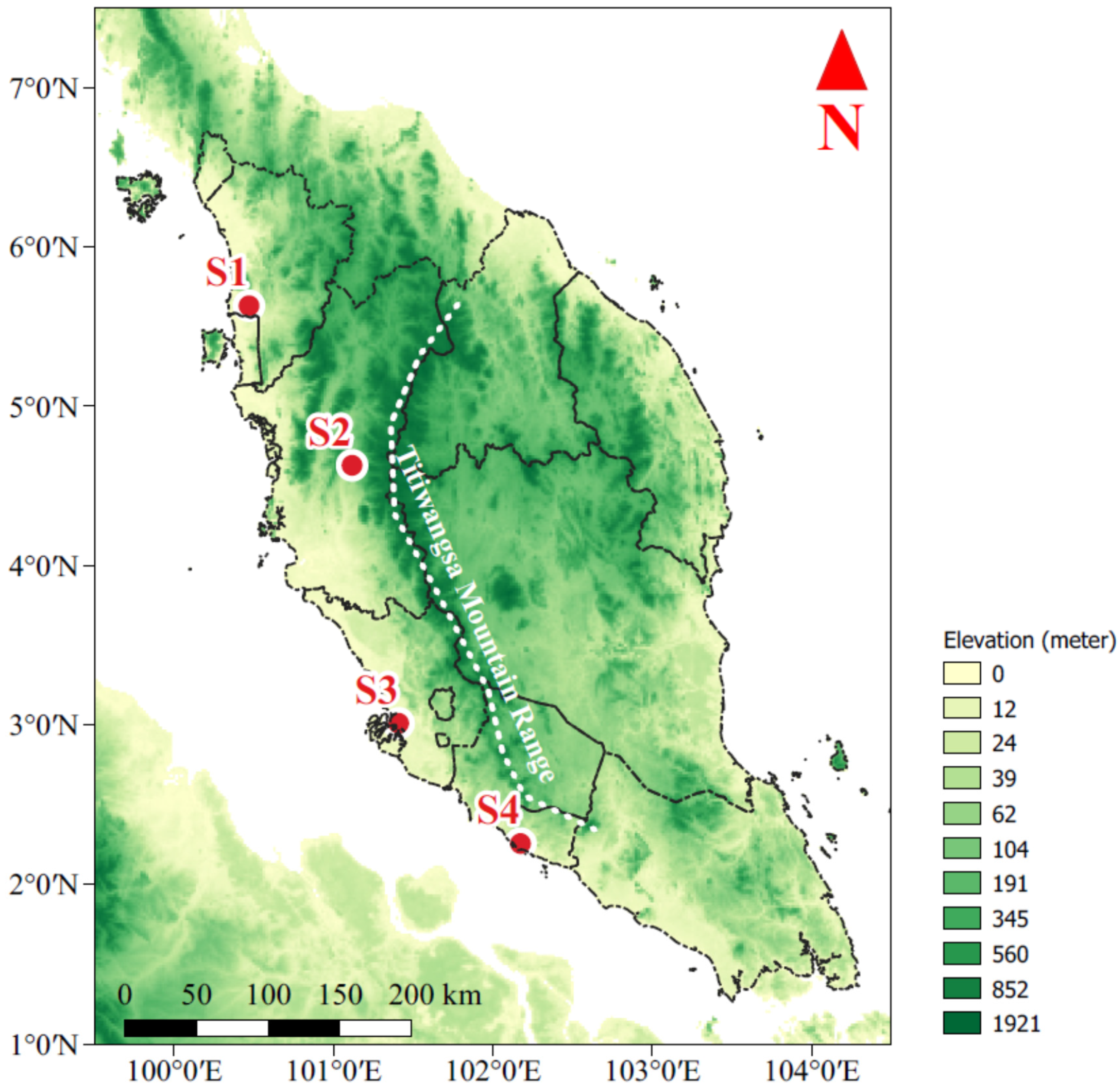
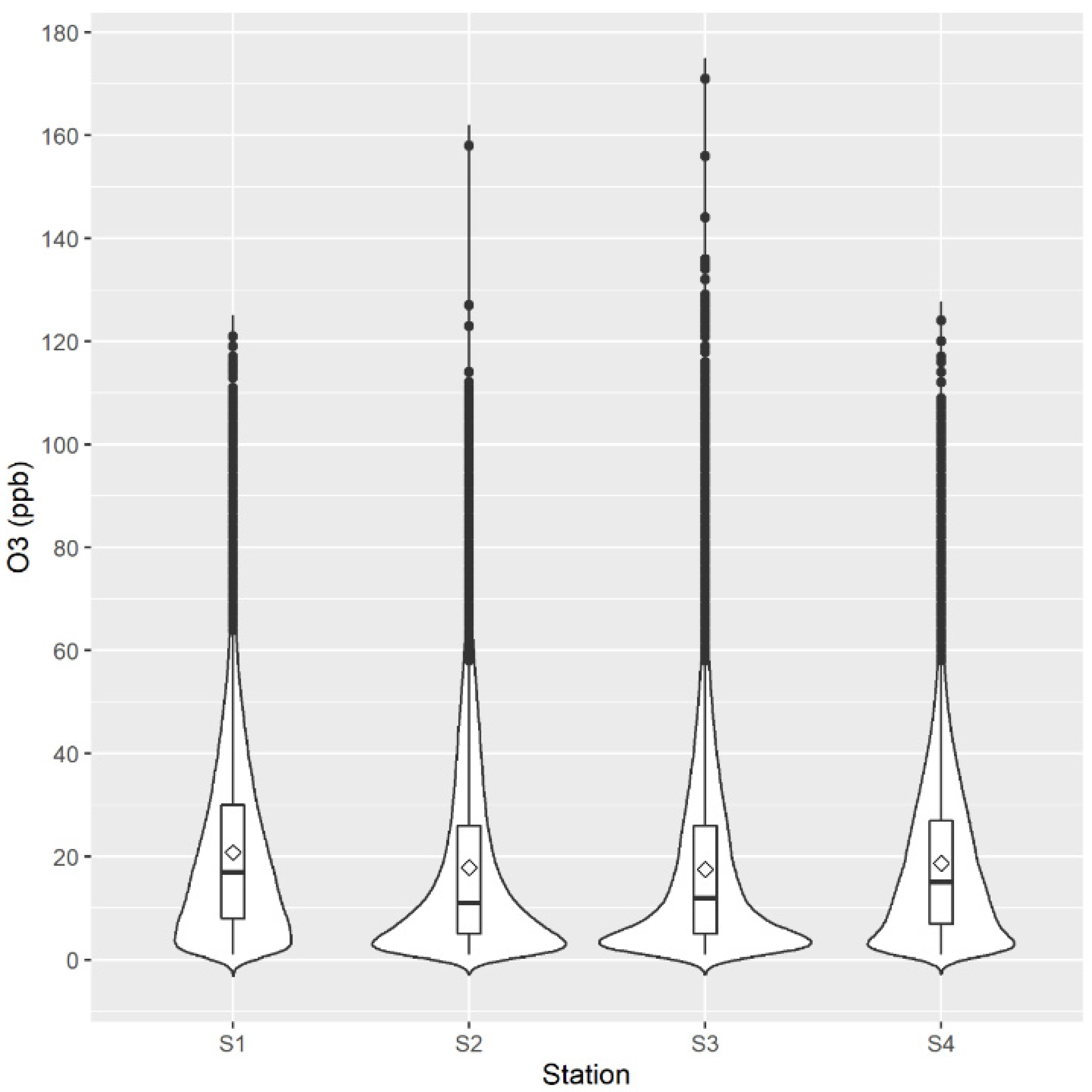
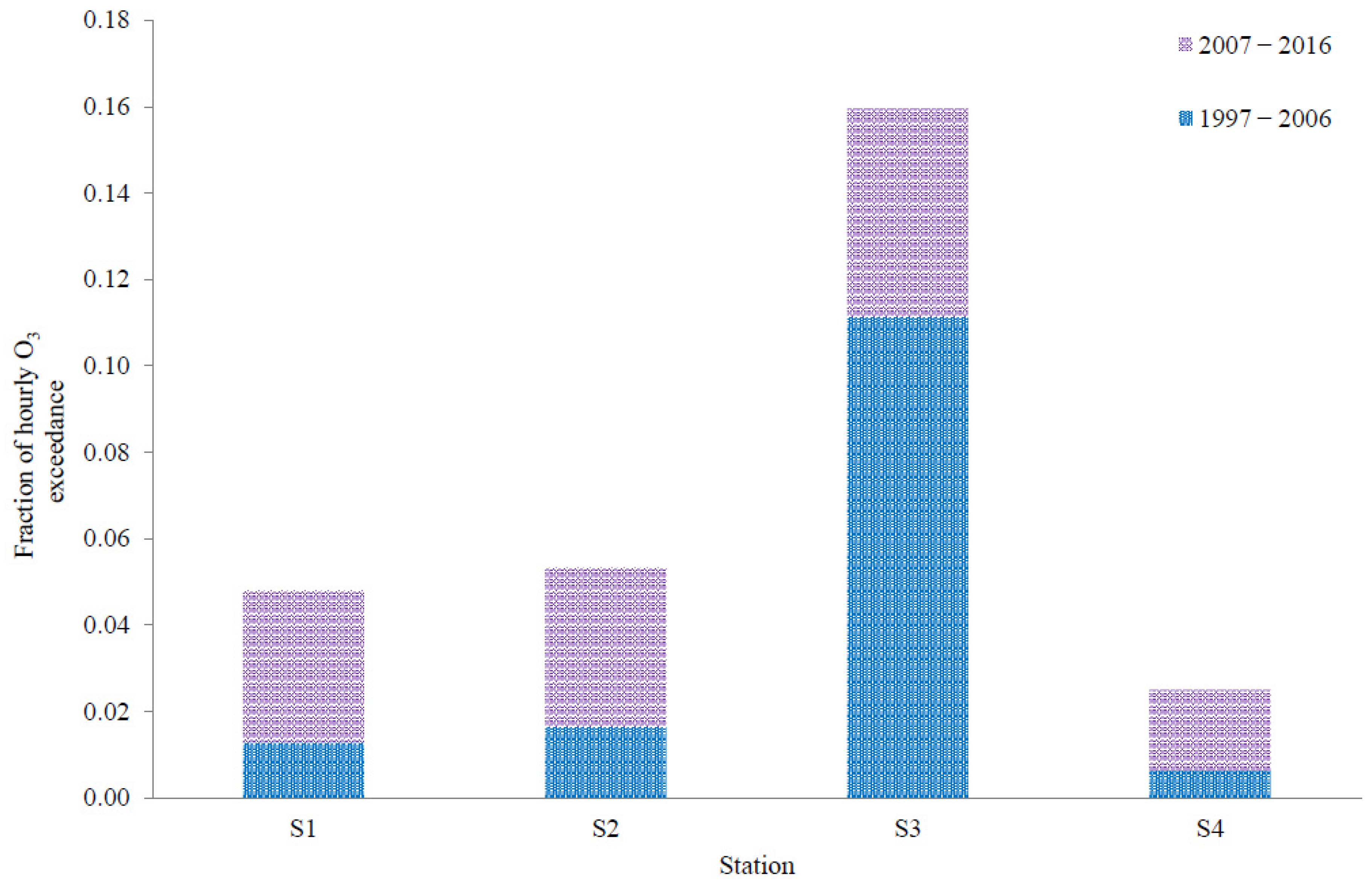
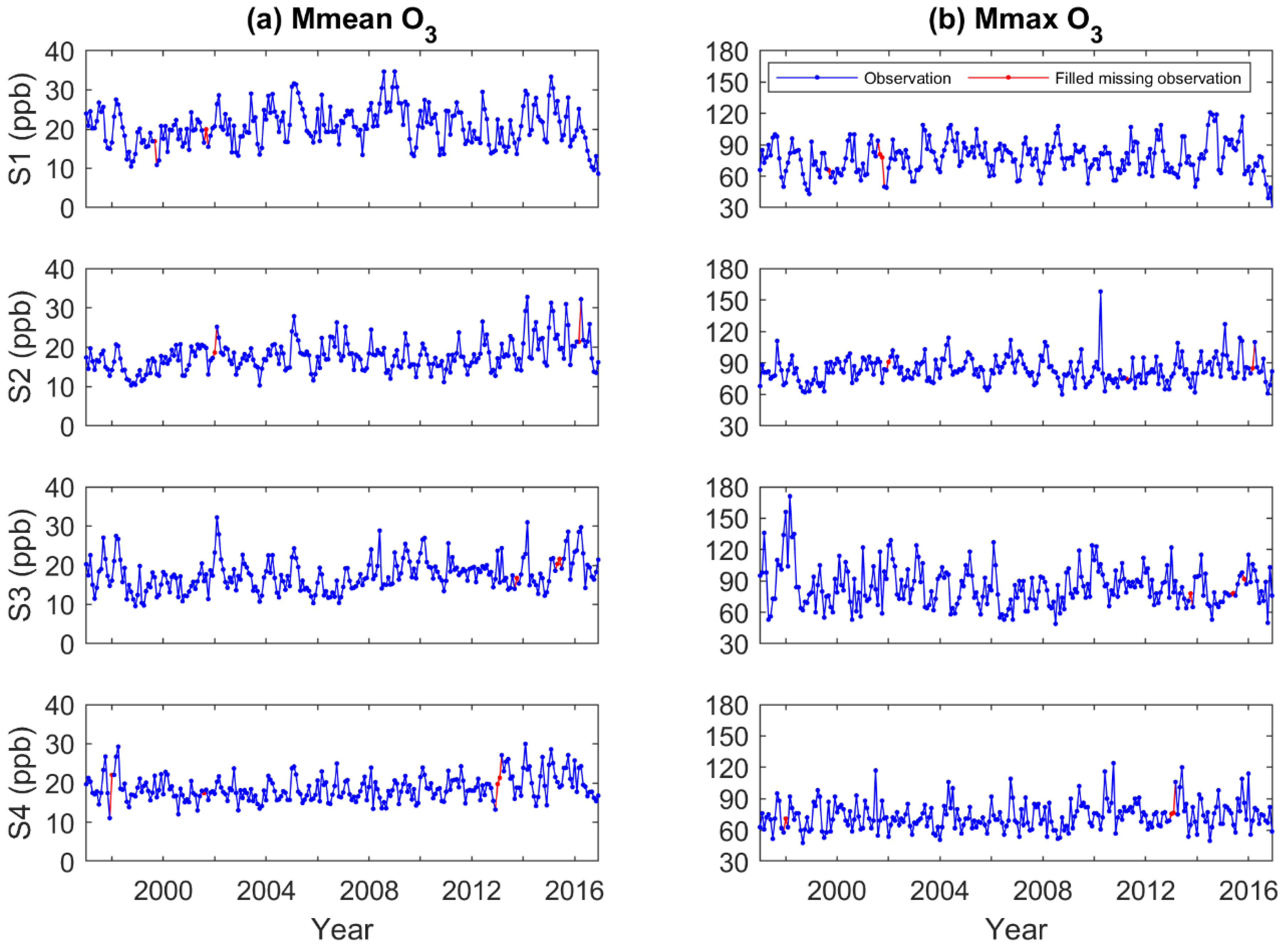
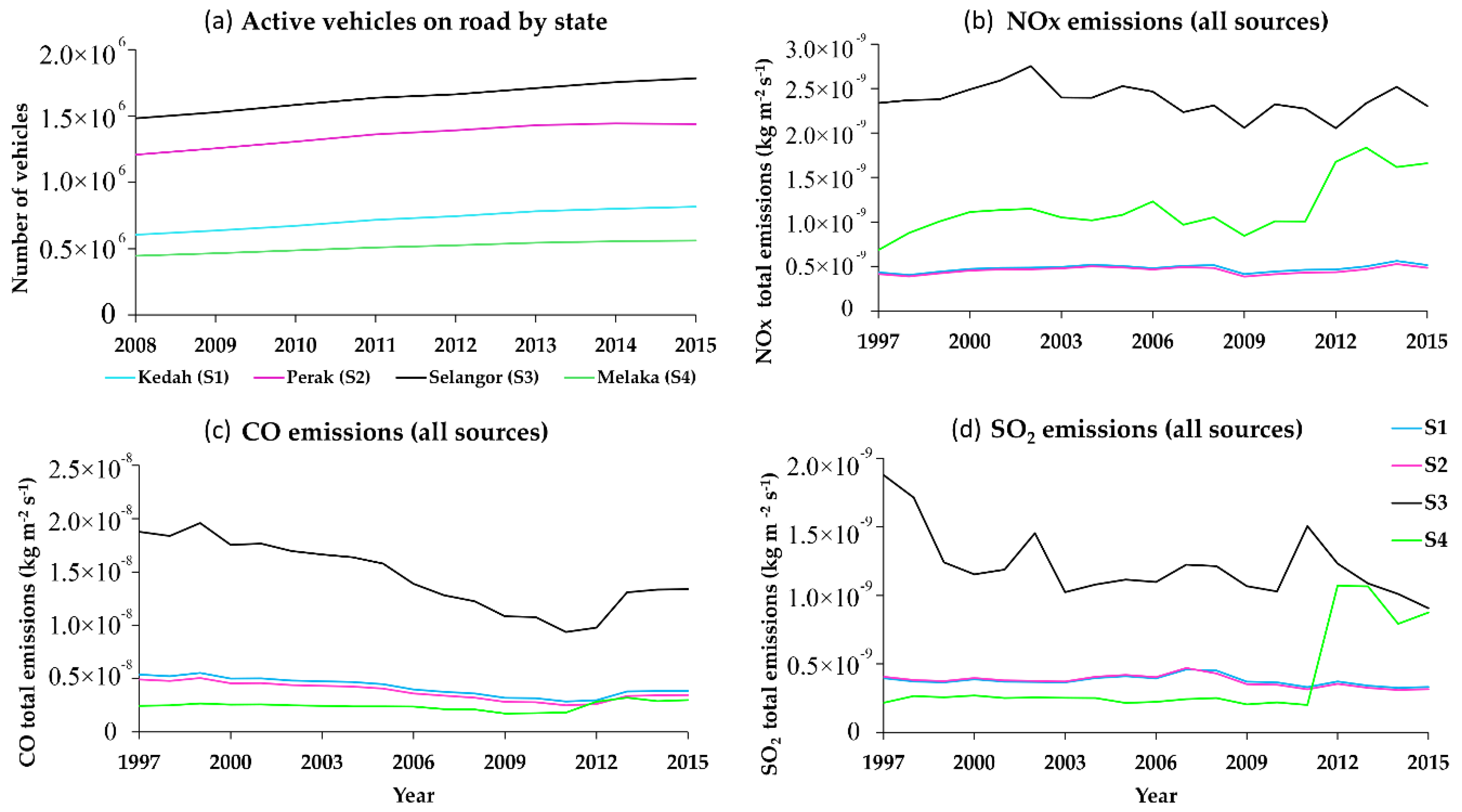
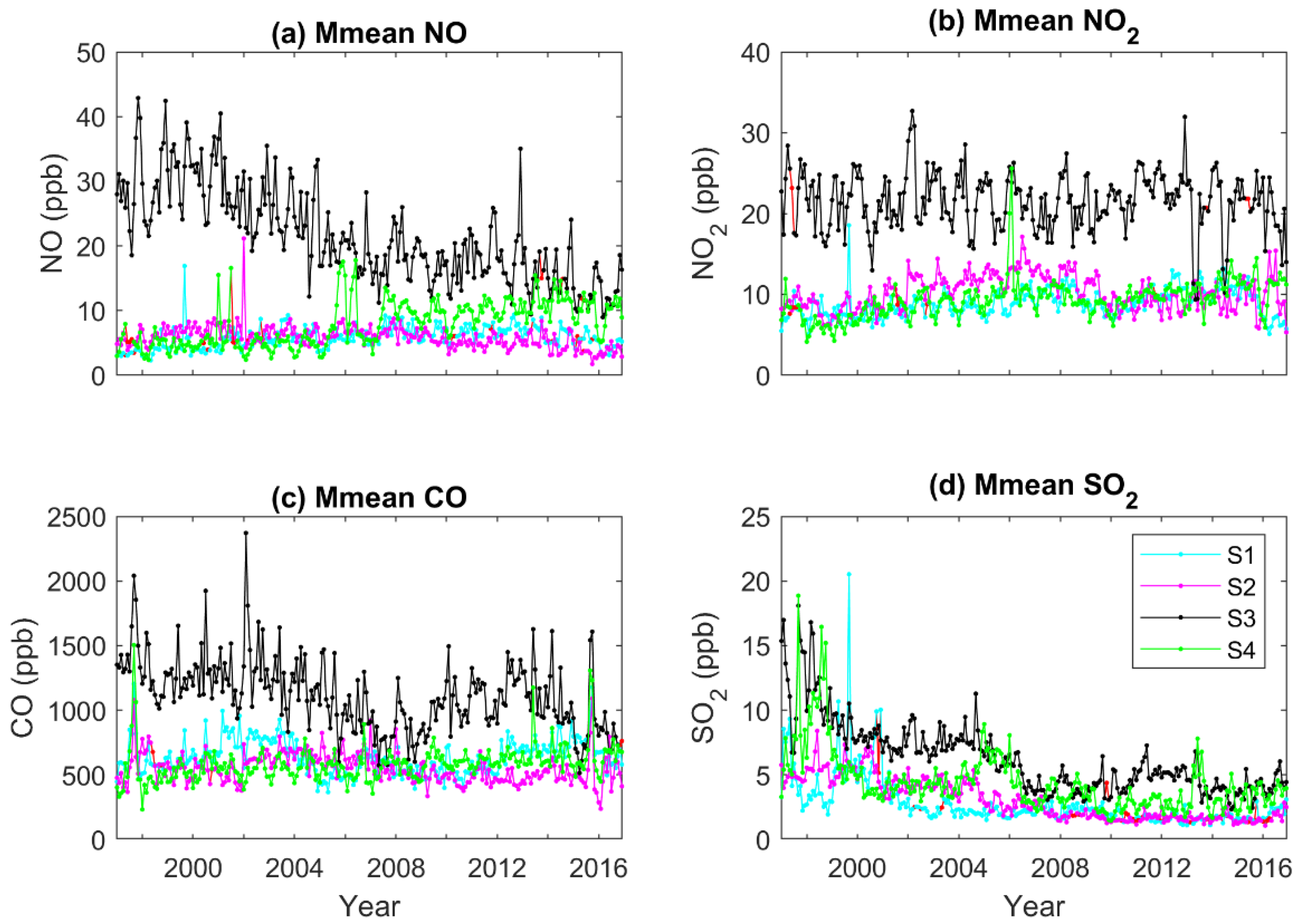
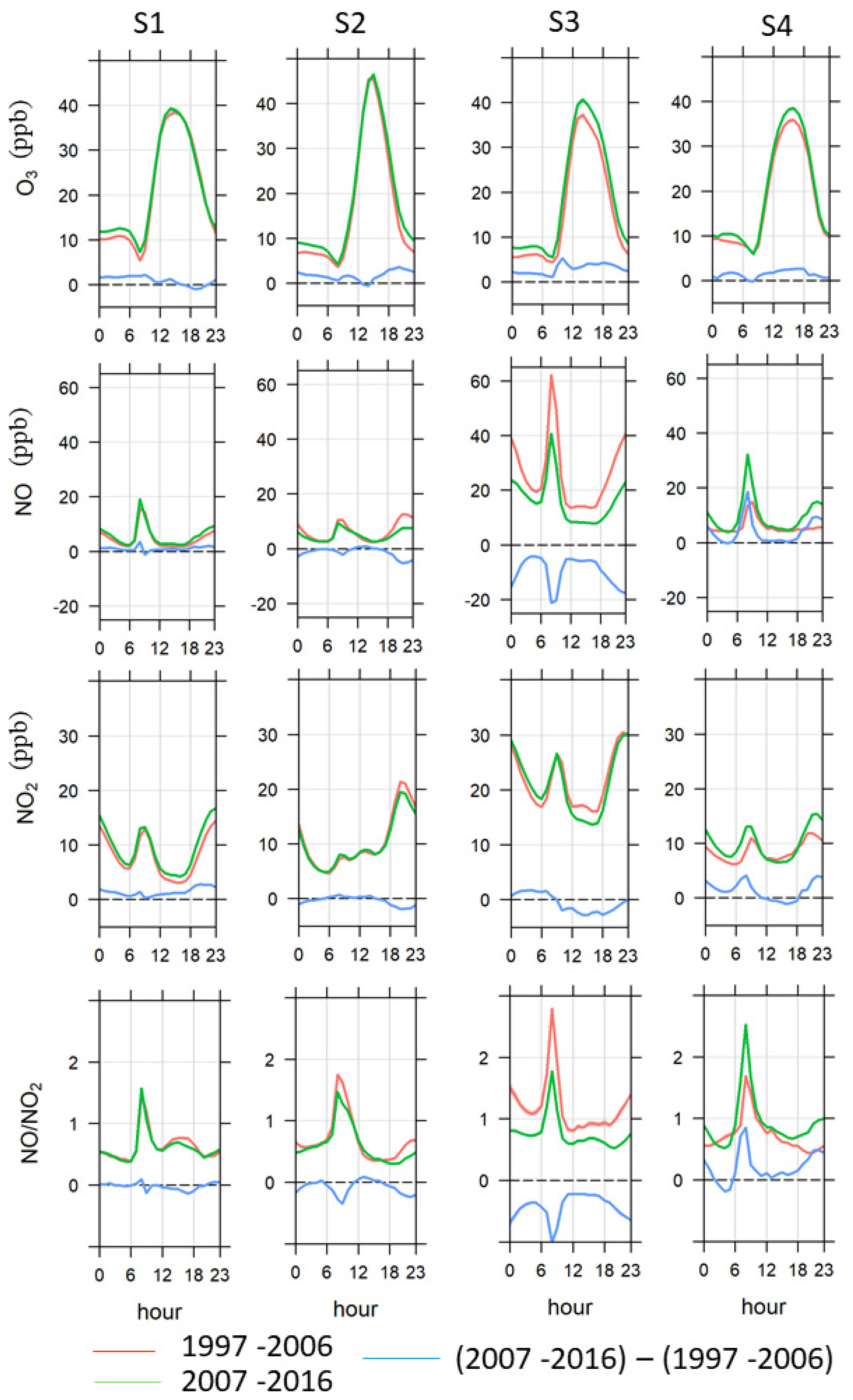
| Station ID | S1 | S2 | S3 | S4 | |
|---|---|---|---|---|---|
| Location | Sungai Petani, Kedah | Tasek Ipoh, Perak | Klang, Selangor | Bukit Rambai, Melaka | |
| Latitude (°N) | 5.6314 | 4.6297 | 3.0103 | 2.2585 | |
| Longitude (°E) | 100.47 | 101.11 | 101.40 | 102.17 | |
| % missing data for 20-year period | O3 | 9.9 | 10.0 | 10.0 | 9.4 |
| NOx | 9.8 | 7.7 | 10.5 | 8.9 | |
| NO | 27.6 | 21.9 | 15.1 | 18.1 | |
| NO2 | 11.1 | 8.6 | 10.7 | 9.4 | |
| CO | 7.1 | 8.8 | 8.0 | 6.6 | |
| SO2 | 26.7 | 17.4 | 9.0 | 14.1 | |
| 1997–2006 | 2007–2016 | 1997–2016 | 1997–2006 | 2007–2016 | 1997–2016 | |
|---|---|---|---|---|---|---|
| Deseasonalized Mmean O3 (ppb yr−1) | Deseasonalized Mmax O3 (ppb yr−1) | |||||
| S1 | 0.51 | −0.44 | 0.09 | 1.25 | −0.24 | 0.13 |
| S2 | 0.36 | 0.42 | 0.19 | 1.06 | 0.15 | 0.03 |
| S3 | −0.17 | 0.25 | 0.21 | −1.35 | 0.33 | −0.15 |
| S4 | −0.09 | 0.44 | 0.13 | −0.21 | 0.38 | 0.3 |
| Deseasonalized Mmean NO (ppb yr−1) | Deseasonalized Mmean NO2 (ppb yr−1) | |||||
| S1 | 0.30 | −0.18 | 0.12 | 0.20 | 0.01 | 0.16 |
| S2 | 0.07 | −0.31 | −0.13 | 0.63 | −0.27 | 0.02 |
| S3 | −1.33 | −0.62 | −0.98 | 0.06 | 0.10 | −0.01 |
| S4 | 0.09 | 0.13 | 0.39 | 0.42 | 0.24 | 0.21 |
| Deseasonalized Mmean NOx (ppb yr−1) | Deseasonalized Mmean NO/NO2 (yr−1) | |||||
| S1 | 0.43 | −0.23 | 0.24 | 0.01 | −0.01 | 0.00 |
| S2 | 0.61 | −0.44 | −0.08 | −0.05 | −0.01 | −0.01 |
| S3 | −1.27 | −0.47 | −0.99 | −0.07 | −0.02 | −0.04 |
| S4 | 0.54 | 0.43 | 0.62 | −0.03 | −0.01 | 0.02 |
| Deseasonalized Mmean CO/NOx (yr−1) | Deseasonalized Mmean SO2/NOx (yr−1) | |||||
| S1 | −4.30 | 3.95 | −1.45 | −0.07 | 0.00 | −0.02 |
| S2 | −2.18 | 1.47 | −0.23 | −0.08 | 0.00 | −0.03 |
| S3 | −0.99 | 0.46 | −0.13 | −0.02 | 0.00 * | −0.01 |
| S4 | −2.14 | 0.34 | −0.91 | −0.05 | 0.00 | −0.02 |
| NO | NO2 | NOx | NO/NO2 | CO/NOx | SO2/NOx | ||
|---|---|---|---|---|---|---|---|
| 1997–2006 | |||||||
| S1 | O3 | −0.28 | 0.27 | −0.17 | −0.5 | 0.12 | −0.04 |
| S2 | −0.46 | 0.64 | 0.33 | −0.69 | −0.19 | −0.34 | |
| S3 | −0.17 | 0.43 | 0.04 | −0.34 | 0.44 | 0.22 | |
| S4 | −0.41 | −0.07 | −0.25 | −0.22 | 0.26 | 0.29 | |
| 2007–2016 | |||||||
| S1 | O3 | −0.23 | 0.25 | 0.02 | −0.39 | −0.06 | 0.12 |
| S2 | −0.55 | 0.38 | 0.01 | −0.67 | 0.09 | −0.07 | |
| S3 | −0.37 | 0.36 | −0.05 | −0.52 | 0.18 | 0.07 | |
| S4 | −0.16 | 0.29 | 0.08 | −0.4 | 0.18 | 0.02 | |
| 1997–2016 | |||||||
| S1 | O3 | −0.18 | 0.27 | −0.01 | −0.43 | −0.03 | −0.04 |
| S2 | −0.51 | 0.5 | 0.11 | −0.69 | −0.06 | −0.24 | |
| S3 | −0.38 | 0.36 | −0.18 | −0.50 | 0.29 | −0.04 | |
| S4 | −0.04 | 0.18 | 0.04 | −0.14 | 0.12 | 0.01 | |
© 2020 by the authors. Licensee MDPI, Basel, Switzerland. This article is an open access article distributed under the terms and conditions of the Creative Commons Attribution (CC BY) license (http://creativecommons.org/licenses/by/4.0/).
Share and Cite
Ahamad, F.; Griffiths, P.T.; Latif, M.T.; Juneng, L.; Xiang, C.J. Ozone Trends from Two Decades of Ground Level Observation in Malaysia. Atmosphere 2020, 11, 755. https://doi.org/10.3390/atmos11070755
Ahamad F, Griffiths PT, Latif MT, Juneng L, Xiang CJ. Ozone Trends from Two Decades of Ground Level Observation in Malaysia. Atmosphere. 2020; 11(7):755. https://doi.org/10.3390/atmos11070755
Chicago/Turabian StyleAhamad, Fatimah, Paul T. Griffiths, Mohd Talib Latif, Liew Juneng, and Chung Jing Xiang. 2020. "Ozone Trends from Two Decades of Ground Level Observation in Malaysia" Atmosphere 11, no. 7: 755. https://doi.org/10.3390/atmos11070755
APA StyleAhamad, F., Griffiths, P. T., Latif, M. T., Juneng, L., & Xiang, C. J. (2020). Ozone Trends from Two Decades of Ground Level Observation in Malaysia. Atmosphere, 11(7), 755. https://doi.org/10.3390/atmos11070755







